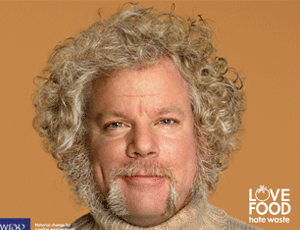Case study: Love Food Hate Waste
By Kaye Wiggins, Third Sector, 16 June 2009

Love Food Hate Waste campaign
A campaign to take the message to the masses, assessed by our expert Simon Myers
Waste and Resources Action Programme, a not-for-profit group backed by the Government, launched its Love Food, Hate Waste campaign in 2007. It was asked to set up a campaign against food waste by the Department for Food, Environment and Rural Affairs and the Scottish and Welsh governments. The latest adverts featured people who have come to resemble their favourite foods. They ran in newspapers and magazines, on buses and online, and the characters were given voices for a radio campaign. The aim was to encourage people to cut down their food waste by offering practical advice in a friendly, accessible tone.
Why these media?
Wrap wanted to take its campaign to the masses, so it opted for a wide range of media, hoping to reach the largest possible audience. It says the decision by a number of local authorities to use the campaign to fill media space they had bought increased the campaign's impact dramatically.
Communicating the message
The campaign's main targets are busy families and couples. The use of everyday foods is designed to capture the audience's attention and warn them not to waste food, without appearing to lecture or be negative. But the link between the characters and the message is not instant. The choice of foods is also surprising: is lamb really one of the most-wasted foodstuffs?
Julia Falcon, PR manager at Wrap, says that when people realise there are eight different characters, they will start to understand the message behind the campaign.
Costs and practicalities
The overall Love Food, Hate Waste campaign, of which these adverts are the latest part, cost £4.1m and took 18 months to develop. The process involved extensive research into food waste in the UK, surveys of attitudes to food waste and consultation with the target audience about the most effective way to communicate the message.
Did it work?
Falcon says Wrap's research shows that in the two years since the campaign was launched two million more households have taken steps to throw less food away. Kaye Wiggins Expert view
- Expert view by Simon Myers, Director, Figtree
'Waste not, want not' has been an unfashionable idea - until now. The double whammy of recession and concern over climate change means that being less wasteful is back in vogue. Society's interest in allotments, eating in and 'scratch-cooking' (buying and cooking the ingredients, like your grandmother did) should make for fertile communications territory.
This campaign has a nice, reassuring, no-nonsense 'Jamie Oliver' tone of voice, but the question remains: what is Wrap and how does it fit in with the other big players in this space such as government, supermarkets and celebrity chefs? They have much higher profiles and are already dispensing words of wisdom and inviting action.
So it is not clear that this campaign is the most effective way to get people to sign up to the Wrap agenda and change their eating habits.
Score
Creativity: 2
Delivery: 3
Total: 5 out of 10

No comments:
Post a Comment